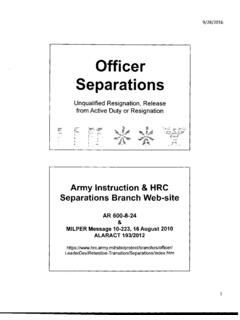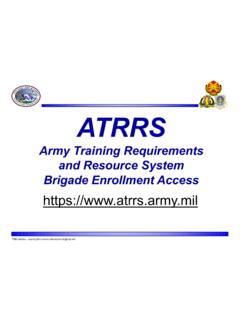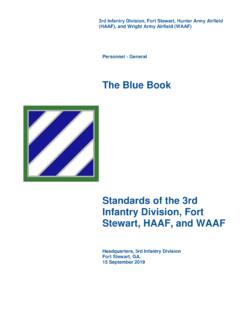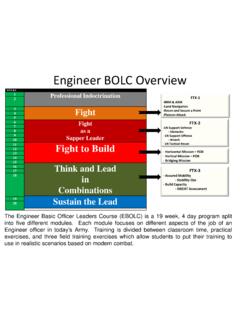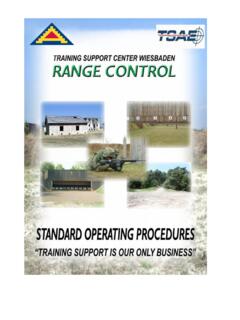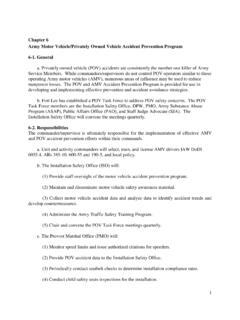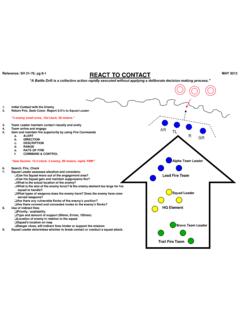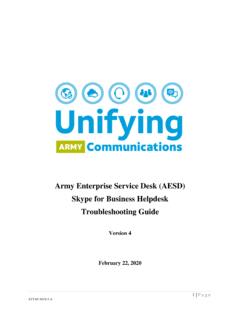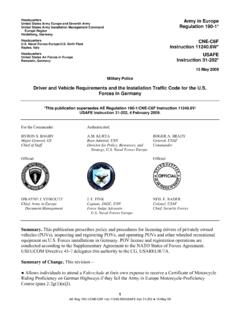Transcription of THE NCO LEADERSHP CENTER OF EXCELLENCE (NCOL CoE)
1 1 Appendix D Individual Student Assessment Plan (ISAP) Individual Student Assessment Plan (ISAP)Basic Leader Course (BLC) January 2019 Noncommissioned Officer Professional Military Education THE NCO LEADERSHP CENTER OF EXCELLENCE (NCOL CoE) 2 D-1. ISAP Overview This appendix contains the policy, procedures, and grading criteria of student assessments. It includes the comprehensive assessments and desired learning outcomes of the BLC IAW TRADOC Regulation 350-70 (10 July 2017). The ISAP lists the course requirements the student must meet in order to graduate from this course. D-2. Course Outcome The BLC prepares Soldiers to lead team size units, by providing an opportunity to acquire the leader skills and knowledge needed to be successful noncommissioned officers. The BLC is the foundation for further education and leader development. D-3. Course Grade Point Average For students who complete Distributed Leader Course I (DLC I): The final grade point average (GPA) for the BLC is a combination of the final DLC I grade and the final BLC GPA.
2 For example, if a student obtained an 80 in the DLC I and a 94 in the BLC, both scores are added and then divided by two for a final BLC GPA on the DA Form 1059 (80 + 94 = 174/2 = a final GPA of 87). D-4. Course Length and Structure a. The BLC is a 22-academic-day course consisting of 169 academic hours. The course includes 22 lessons designed around the four Army Learning Areas (ALAs), the 14 General Learning Outcomes (GLOs), and the six Leader Core Competencies (LCC) of: readiness , Leadership, Training Management, Communications, Operations, and Program Management. b. The lesson titles and sequence are shown on the Course Map. See paragraph 1-5, Course Structure. D-5. Course Learning Objectives Lesson Title Outcomes B100 BLC Overview / Blackboard Identify the standards, procedures, and assessment requirements for the Basic Leader Course (BLC). B101 Group Dynamics Summarize the components of group dynamics as they relate to the learning environment. B102 Effective Listening Use the components of the listening process for improved communication.
3 B103 Written Communication Apply the components of the basic English, grammar, writing, and the editing process. B104 Public Speaking Demonstrate confidence when delivering a briefing/oral presentation. B105 Critical Thinking & Problem Solving Solve problems using critical and creative thinking. B106 Army s Leadership Requirements Model Describe the Army's Leadership Requirements Model. B107 Counseling Build effective counseling skills. B108 Cultural Competence Adapt your leadership style to the cultural environment. B109 Army Values, Ethics, & Integration of Soldier 2020 Justify the need to adhere to a strong set of values and ethics that support the Army profession. B110 Legal Responsibilities & Limits of NCO Authority Understand the legal authorities, responsibilities, and limits of an NCO. 3 Course Learning Objectives (Continued) B111 Introduction to Physical readiness Training Apply components of the Army Physical readiness Training Program. B112 Followership & Servant Leadership Fundamentals Describe the characteristics of the effective follower and the principles of servant leadership B113 Team Building & Conflict Management Build effective teams.
4 B114 Drill & Ceremonies Conduct squad drill. B115 Mission Orders & Troop Leading Procedures Apply troop leading procedures (TLP). B116 Training Management / Conduct Individual Training Instruct a skill level 1 task, during a team level training session, using the Army s 8-step training outline. B117 Soldier for Life Transition Assistance Program (SFL TAP) Discuss the Soldier for Life Transition Assistance Program (SFL-TAP) and prepare a basic resume. B118 Command Supply Discipline Program Connect being a good steward of Army resources to maintaining unit readiness through effective supply discipline. B119 Soldier readiness Organize team level requirements under the pillars of readiness . B121 Resiliency Assist Soldiers to be ready and resilient at all times to meet unit missions. B122 End of Course Essays Reflect on the Basic Leader Course content by expressing and integrating learning into professional practice using the writing and editing process. B123 Army Physical Fitness Test Maintain individual readiness and fitness.
5 D-6. Course Graduation Criteria and Requirements a. The graduation requirements are shown in the two tables below. The tables also indicate if the assessment is part of the student s GPA or not. See each of the individual assessments for specific criteria. Assessment Title Associated Lesson Grade Point Average 1009S Public Speaking and Information Briefing B104 GPA 1009W Assessing Writing, Compare and Contrast Essay B112 GPA 1009W Assessing Writing, Informative Essay B103 GPA Conduct Individual Training Rubric B116 GPA Conduct Physical readiness Training Rubric B111 GPA Conduct Squad Drill Rubric B114 GPA 4 b. There are six assessments that are mandatory and graduation requirements, but do not count toward the student GPA as shown in the table below. Assessment Title Associated Lesson Grade Point Average Compliance with the Army Body Composition Program In-Processing Non-GPA The Army Physical Fitness Test (APFT) B123 Non-GPA 1009A Assessing Attributes and Competencies Entire course Non-GPA 1009 W Special, Assessing Reflective Writing B122 Non-GPA 1009W Special, Resume B117 Non-GPA SHARP Essay (Commandant s Writing Award) B100 Non-GPA D-7.
6 Counseling, Retraining, Retesting/REA, Dismissal, and Appeals Policy a. At a minimum, Soldiers will be counseled using DA Form 4856, referencing assessments as appropriate, on the following events: Reception and integration Any failure of an assessment and/or graduation requirement Any violation of student conduct, SHARP, or local policy End of course results Recommendation for dismissal or disenrollment Dismissal b. Remedial Educational Assessments (REA) are necessary when Soldiers/students fail an assessment. Soldiers are strongly encouraged to conduct their own collaborative sessions/study halls, if not mandated to do so. c. Remedial Educational Assessments will occur anytime a student fails an assessment for the first time except for the 1009A Assessing Attributes and Competencies. Soldiers who fail a REA will be recommended for dismissal. The NCOA deputy commandant is the dismissal authority and the commandant is the appellate authority for all dismissals.
7 Facilitators will conduct the REA after necessary retraining/study hall. Any REA should be accomplished outside of the course hours to preclude the student missing any scheduled classes. The following restrictions listed below must be imposed: Height/Weight failure: Soldiers are allowed one re-screening. The re-screening will be administered no earlier than seven days after the initial height/weight assessment APFT failure: Soldiers are allowed one retest. The retest will be administered no earlier than seven days after the initial APFT assessment Soldiers who meet academic course requirements, but fail to meet the APFT and/or height and weight standards will be dismissed from the course NCOA commandants will not add to the standards of AR 600-9 by imposing any arbitrary percentages to the body fat composition d. Student Dismissal: Students may be considered for dismissal from courses for the following reasons: Personal conduct is such that continuance in the course is not appropriate (for example, if a student violates regulations, policies, or established discipline standards).
8 No formal adjudication of guilt by a military or civilian court or by a commander under UCMJ, Art. 15 is necessary to support dismissal under this paragraph. Negative attitude or lack of motivation, either of which is prejudicial to the interests of other students in the class. 5 Academic deficiency demonstrated by failure to meet course standards or lack of academic progress that makes it unlikely that the student can successfully meet the standards established for graduation. Illness or injury (as determined by a physician), or added physical profile limitation. Compassionate reasons. Students enrolled as a military member retiring or leaving the military and not continuing in a federal civilian capacity. e. Students being considered for dismissal must have been counseled by the chain of command (usually the assigned trainer or small group leader, the course manager, and the school commandant or commander, or a designated representative who has direct responsibility for the course), with an opportunity to correct deficiencies, prior to consideration for dismissal.
9 Counseling sessions will be documented and signed by all counselors and acknowledged by the student. All counseling forms will be maintained with the student s records. Additionally, the school commandant or designated representative will notify the commander of the student s parent unit or parent organization, when possible. f. The following procedures apply in cases where dismissal is considered for motivational, disciplinary, or academic reasons: The training supervisor will notify the student in writing of the proposed action, the basis for the action, the consequences of disenrollment, and the right to appeal. The supervisor will advise the student that any appeal must be submitted within seven (7) duty days after receipt of the written notification of the dismissal action. (Example C-5 I) The training supervisor will make a recommendation to the dismissal authority that the student be dismissed from the course. (Example C-5 II) The written notification must advise the student of the right to appeal within seven (7) duty days to the school commandant or commander.
10 (Example C-5 III) The student will acknowledge by endorsement within two (2) duty days receipt of the written notification of dismissal action. The endorsement must indicate whether or not the student intends to appeal the dismissal action. (Example C-5 IV) Appeals will be forwarded to the school commandant or commander who will refer the proposed action and the appeal to the Office of the Staff Judge Advocate to determine legal sufficiency of the dismissal decision. All appellate actions will become part of the student s case file. Commandants and commanders will make their final decision on dismissals after considering the supporting Office of the Staff Judge Advocate recommendation. In cases where an Office of the Staff Judge Advocate is not available, the commandant or commander will forward appeals to the commander who has General Court Martial Convening authority for review and final decision; General Court Martial Convening Authorities will obtain a legal review before final action.
